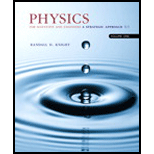
(a)
The speed and direction of each ball in the reference frames.
A reference frame that moves with the ball 1.
(a)
Answer to Problem 1CQ
Solution:
Ball 1 has speed 0 m/s appears to be at rest.
Ball 2 has speed 9 m/s and direction to the left.
Explanation of Solution
Given information :
The following figure if two balls are given

Calculation:
The relative velocities of the balls are used to find the speed and direction of the two balls with respect to the reference frames moving with the balls.
The direction to the right is taken as positive, and the left as negative.
The two balls are shown in the figure:
The ball 1 moves to the right, hence the velocity (
The ball 2 moves to the left, hence the velocity (
A reference frame that moves with ball 1.
The velocity of the reference frame,
The relative velocity of ball 1 (
The relative velocity of ball 2 (
Negative sign indicates direction to the left.
When the reference frame moves with the ball 1:
- Ball 1 has speed = 0 m/s and appears to be at rest.
- Ball 2 has speed = 9 m/s and has direction to the left.
Conclusion:
When the reference frame moves with the ball 1.
Ball 1 has speed = 0 m/s and appears to be at rest.
Ball 2 has speed = 9 m/s, direction to the left.
(b)
The speed and direction of each ball in the reference frames.
A reference frame that moves with the ball 2.
(b)
Answer to Problem 1CQ
Solution:
Ball 1 has speed of 9 m/s and direction to the right
Ball 2 has speed of 0 m/s and appears to be at rest.
Explanation of Solution
A reference frame that moves with the ball 2
The velocity of the reference frame,
The relative velocity of ball 1 (
Positive sign indicates direction to the right.
The relative velocity of ball 2 (
When the reference frame moves with ball 2.
- Ball 1 has speed = 9 m/s and has direction to the right
- Ball 2 has speed = 0 m/s and appears to be at rest.
Conclusion:
When the reference frame moves with ball 2.
Ball 1 has speed = 9 m/s and has direction to the right.
Ball 2 has speed = 0 m/s and appears to be at rest.
Want to see more full solutions like this?
Chapter 36 Solutions
Physics for Scientists and Engineers: A Strategic Approach, Vol. 1 (Chs 1-21) (4th Edition)
- Mick and Rick are twins born on Earth in the year 2175. Rick grows up to be an Earth-bound robotics technician while Mick becomes an intergalactic astronaut. Mick leaves the Earth on his first space mission in the year 2200 and travels, according to his clock, for 10 years at a speed of 0.75c. Unfortunately, at this point in his journey, the structure of his ship undergoes mechanical breakdown and the ship explodes. How old is Rick when his brother dies?arrow_forwardHi, I have canceled, why did you charge me again?arrow_forwardNo chatgpt pls will upvotearrow_forward
 College PhysicsPhysicsISBN:9781305952300Author:Raymond A. Serway, Chris VuillePublisher:Cengage Learning
College PhysicsPhysicsISBN:9781305952300Author:Raymond A. Serway, Chris VuillePublisher:Cengage Learning University Physics (14th Edition)PhysicsISBN:9780133969290Author:Hugh D. Young, Roger A. FreedmanPublisher:PEARSON
University Physics (14th Edition)PhysicsISBN:9780133969290Author:Hugh D. Young, Roger A. FreedmanPublisher:PEARSON Introduction To Quantum MechanicsPhysicsISBN:9781107189638Author:Griffiths, David J., Schroeter, Darrell F.Publisher:Cambridge University Press
Introduction To Quantum MechanicsPhysicsISBN:9781107189638Author:Griffiths, David J., Schroeter, Darrell F.Publisher:Cambridge University Press Physics for Scientists and EngineersPhysicsISBN:9781337553278Author:Raymond A. Serway, John W. JewettPublisher:Cengage Learning
Physics for Scientists and EngineersPhysicsISBN:9781337553278Author:Raymond A. Serway, John W. JewettPublisher:Cengage Learning Lecture- Tutorials for Introductory AstronomyPhysicsISBN:9780321820464Author:Edward E. Prather, Tim P. Slater, Jeff P. Adams, Gina BrissendenPublisher:Addison-Wesley
Lecture- Tutorials for Introductory AstronomyPhysicsISBN:9780321820464Author:Edward E. Prather, Tim P. Slater, Jeff P. Adams, Gina BrissendenPublisher:Addison-Wesley College Physics: A Strategic Approach (4th Editio...PhysicsISBN:9780134609034Author:Randall D. Knight (Professor Emeritus), Brian Jones, Stuart FieldPublisher:PEARSON
College Physics: A Strategic Approach (4th Editio...PhysicsISBN:9780134609034Author:Randall D. Knight (Professor Emeritus), Brian Jones, Stuart FieldPublisher:PEARSON





